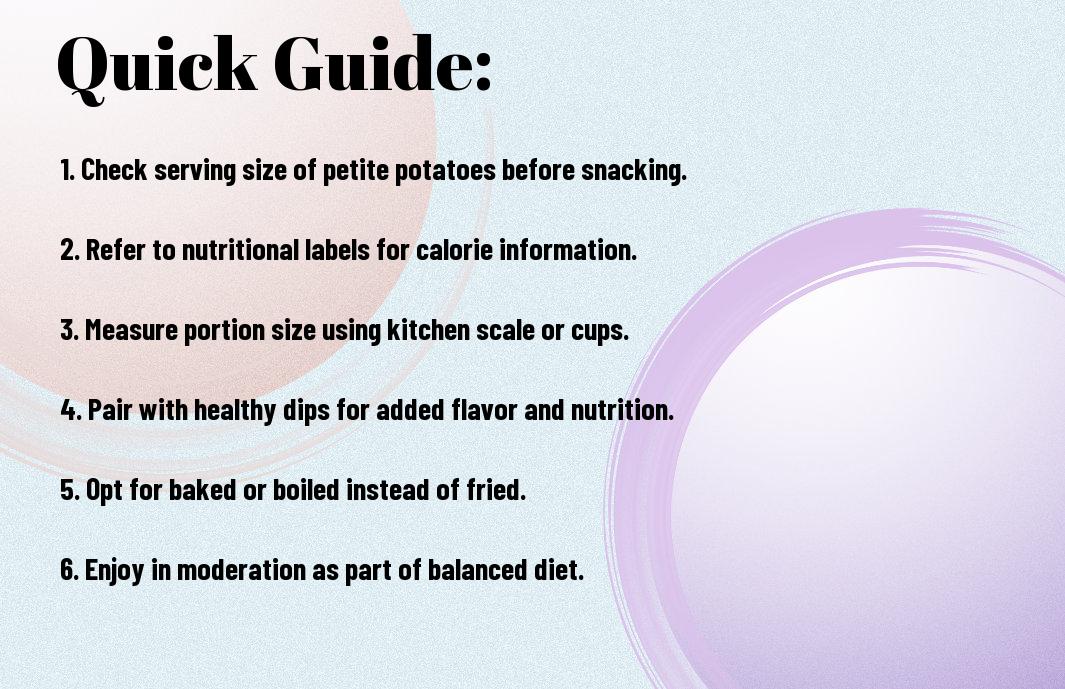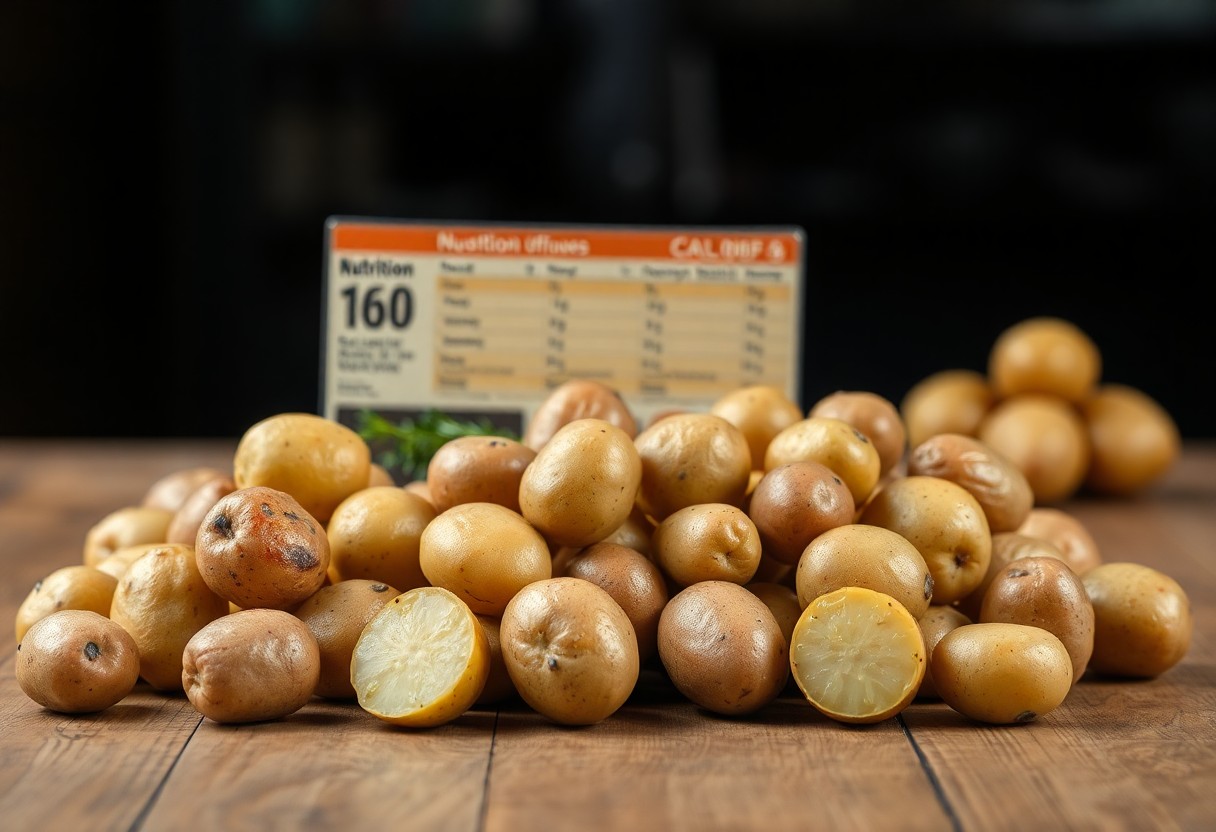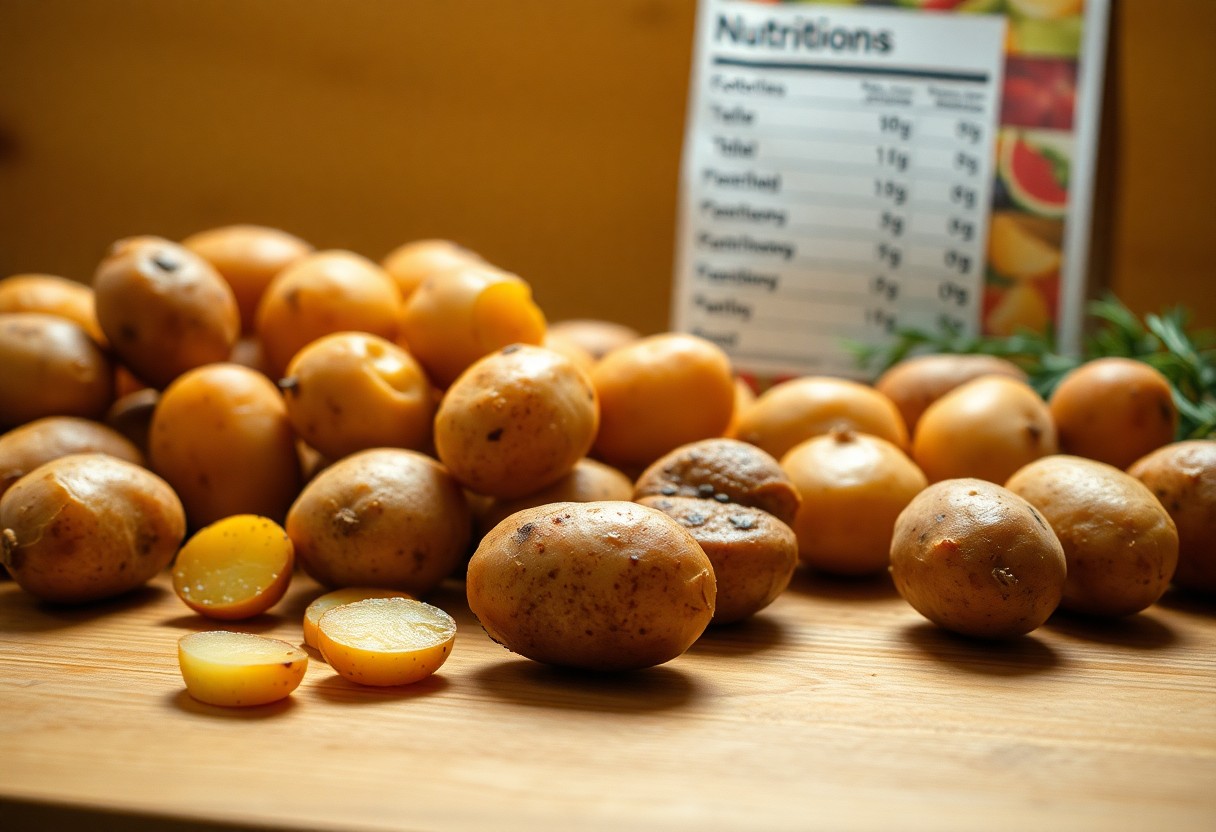Snacking can be a delightful way to enjoy food without the full commitment of a meal. If you’re considering adding petite potatoes to your snack list, you might be wondering about their calorie content. These small spuds are not only low in calories but also packed with nutrients, making them a wise choice for satisfying your hunger. In this guide, you’ll learn exactly how many calories are in petite potatoes and discover tips on how to incorporate them into your healthy snacking routine.
Key Takeaways:
- Petite potatoes are a low-calorie snack option, typically containing around 120 calories per cup when cooked.
- They are not only low in calories but also packed with crucial nutrients, including vitamins C and B6, making them a nutritious choice for snacking.
- Portion control is key; enjoying petite potatoes in moderation can contribute to a balanced diet while satisfying your hunger.


Types of Petite Potatoes
A diverse array of petite potatoes is available to enhance your meals and snacks. Here’s a brief overview of the main types:
| Type | Characteristics |
|---|---|
| Baby Yukon Gold | Creamy texture, rich flavor |
| Fingerling | Nutshell shape, earthy taste |
| Red Bliss | Smooth skin, subtle sweetness |
| New Potatoes | Harvested early, tender and sweet |
| Petite White Potatoes | Neutral flavor, versatile |
This variety brings not only different flavors but also various nutritional benefits that cater to your dietary needs.
Varieties and Nutritional Profiles
To choose the right petite potato for your snacking or cooking needs, understand their varying nutritional profiles. Most petite potatoes are low in calories, with a satisfying carbohydrate content. For instance, Baby Yukon Gold and Fingerling provide good fiber and vitamin C, enhancing not just snack time but overall health.
Culinary Uses and Flavor Differences
Potatoes come in versatile forms, and each type brings unique culinary potential. Whether roasting, boiling, or mashing, your choice of petite potato can elevate the dish. For example, Baby Yukon Gold is great for creamy mashed potatoes while Fingerlings shine when roasted with herbs.
Flavor plays a significant role in your cooking and snacking experience. Earthy varieties like Fingerlings offer a robust taste that pairs well with hearty dishes, while Red Bliss has a gentle sweetness that complements salads. Selecting the right petite potato can make a notable difference in texture and taste, directly impacting your culinary creations. Be sure to explore these diverse options for a delicious experience!
Understanding Calories in Petite Potatoes
Clearly, petite potatoes are a delightful and versatile snack option that packs nutritional benefits along with their flavorful appeal. Understanding the calorie content in petite potatoes is vital for maintaining a balanced diet while enjoying tasty snacks. With their small size, petite potatoes give you the satisfaction of a filling snack without overwhelming your calorie intake.
Average Caloric Content
Some petite potatoes contain approximately 120 calories per 100 grams. They are low in fat and provide valuable nutrients such as potassium and vitamin C, making them an excellent choice for health-conscious snackers.
Comparison with Other Snack Options
Caloric content can profoundly influence your snacking habits, especially when comparing petite potatoes to other popular snack options. Here’s a breakdown to consider:
Snack Options Comparison| Petite Potatoes | 120 calories (100g) |
| Potato Chips | 536 calories (100g) |
| Granola Bars | 450 calories (100g) |
| Popcorn (buttered) | 535 calories (100g) |
Calories in snack options vary significantly, and petite potatoes emerge as a favorable choice. They offer a balanced, low-calorie alternative to higher-calorie options such as potato chips and granola bars. By opting for petite potatoes, you not only reduce your overall calorie intake but also enjoy a healthy serving of fiber and vitamins.

Tips for Smart Snacking with Petite Potatoes
All you need are some simple strategies to enjoy petite potatoes as a nutritious snack. Consider these tips to elevate your snacking game:
- Pair petite potatoes with a source of protein like yogurt or hummus
- Season with herbs and spices instead of heavy sauces
- Incorporate them into salads for added texture
- Roast or steam instead of frying
After incorporating these tips, you’ll find that snacking on petite potatoes can be both satisfying and healthy.
Portion Control Strategies
Potatoes can be easily overindulged, which is why portion control is crucial. To keep your snacking in check, try using a small bowl or plate to serve your petite potatoes. This visual cue helps you gauge the right amount without counting every calorie. You can also pre-portion your snacks into single servings to avoid going back for seconds.
Healthy Preparation Methods
Healthy preparation methods can significantly enhance the benefits of petite potatoes. Instead of frying, opt for baking, steaming, or boiling to maintain their nutritional value while reducing unnecessary fats. Add bright colors and flavors by tossing them with fresh herbs or spices, which can invigorate your taste experience without adding empty calories. Portioning your seasoned petite potatoes can also contribute to a well-balanced diet, keeping your snacking both delicious and smart.
Tips for prepping your petite potatoes include using minimal oil and exploring various spices to maximize flavor. Experiment with herbs like rosemary or thyme, and you can even create dips with garlic or yogurt. Always remember, simple cooking techniques not only keep your potatoes healthy but also preserve their natural sweetness and nutrients. Enjoy them roasted, grilled, or simply mashed for a wholesome snack!
Step-by-Step Guide to Preparing Petite Potatoes
After gathering your petite potatoes, it’s time to prepare them for a delicious snack. Follow these steps for perfectly cooked potatoes:
| Step | Action |
| 1 | Wash the potatoes thoroughly under cold water. |
| 2 | Trim any blemishes or bad spots with a knife. |
| 3 | Boil them in salted water for about 15-20 minutes until tender. |
| 4 | Drain and let cool slightly before serving. |
Cooking Techniques
Any of the following cooking techniques can elevate your petite potatoes to a delightful snack. You can steam, roast, grill, or boil your potatoes. Each method brings out a different flavor profile and texture, so choose one that fits your taste preferences and dietary needs.
Flavor Enhancements
For a more satisfying flavor, consider these enhancements. Your petite potatoes can shine with various herbs, spices, and sauces. Simple seasonings like salt, pepper, and olive oil work wonders.
Guide your culinary journey by experimenting with fresh herbs like rosemary or thyme, or a sprinkle of parmesan cheese for an added richness. You can even add a dash of garlic powder or paprika for that extra kick. These enhancements not only elevate the flavor but also create a sophisticated snacking experience. Enjoy discovering combinations that best suit your palate!
Factors Affecting Caloric Content
Now, understanding the caloric content of petite potatoes goes beyond their inherent nutrition. Several factors can influence how many calories you consume. These factors include:
- Cooking methods
- Added ingredients and toppings
- Portion sizes
- Preparation techniques
After considering these aspects, you can make more informed snacking choices.
Cooking Methods
On average, the way you cook your petite potatoes significantly impacts their overall calories. Boiling or steaming can preserve their natural nutrients while keeping caloric content lower, in contrast to frying them in oil, which adds unnecessary fat and calories. Choosing the right method can help you enjoy this healthy snack without overindulging.
Added Ingredients and Toppings
Cooking with additional ingredients can dramatically raise the total caloric count of petite potatoes. Whether you choose butter, cheese, or creamy sauces, these toppings can turn a healthy option into a calorie-dense dish.
Caloric intake from petite potatoes can skyrocket based on what you add. For instance, a dash of olive oil or a sprinkle of cheese might enhance flavor but can add significant calories. Opting for spices or herbs can enrich taste without the extra calories, making your snack not only tastier but also healthier. Understanding what enhances your potatoes while keeping calories in check allows you to enjoy them guilt-free.
Pros and Cons of Snacking on Petite Potatoes
Once again, it’s crucial to weigh the pros and cons when considering petite potatoes as a snack. Here’s a breakdown of what you should know:
Pros and Cons
| Pros | Cons |
|---|---|
| Low in calories | May cause bloating in some individuals |
| Rich in potassium | Can have high carb content |
| Good source of fiber | May lead to overeating if not portioned |
| Versatile in recipes | Potential for high sodium if salted heavily |
| Easy to prepare | Lower protein content |
Health Benefits
Now, petite potatoes can be a smart snacking option due to their impressive health benefits. They are low in calories while providing crucial nutrients like fiber and potassium, which can help support heart health and digestive function. Additionally, their fiber content may promote fullness, making you less likely to indulge in less nutritious snacks.
Potential Drawbacks
Potential drawbacks exist when snacking on petite potatoes. While they offer many health benefits, be aware of their higher carbohydrate content, which may not align with certain dietary restrictions. Additionally, some individuals might experience discomfort like bloating or gas, especially if consumed in large quantities.
Another consideration is the risk of overeating when you don’t measure your portions accurately. This can lead to *excessive carb intake*, impacting your energy levels and weight management. Always be cautious of how much you consume, and aim for a balance that aligns with your dietary goals to avoid potential *negative effects* on your health.
Summing up
Conclusively, petite potatoes can be a nutritious and satisfying snack option for you, with approximately 130 calories per cup. They provide necessary vitamins and minerals while being low in calories, making them a smart choice for maintaining your health. Choosing to include petite potatoes in your diet not only offers variety but also supports your snacking habits by keeping it both enjoyable and guilt-free. By understanding their calorie content, you can make informed choices that align with your health goals.
FAQ
Q: How many calories are typically in petite potatoes?
A: Petite potatoes generally contain about 110 to 120 calories per medium-sized serving (approximately 5–6 small potatoes). However, the exact calorie count can vary depending on the cooking method and any additional ingredients used.
Q: Are petite potatoes a healthy snack option?
A: Yes, petite potatoes can be a healthy snack choice! They are low in calories, provide vital vitamins and minerals (such as potassium and vitamin C), and contain dietary fiber, which supports digestive health. When prepared simply, they can be a nutritious addition to your diet.
Q: How can I prepare petite potatoes for a low-calorie snack?
A: For a low-calorie snack, try steaming or boiling petite potatoes without adding butter or heavy sauces. A sprinkle of salt and herbs can enhance their flavor without significantly increasing calorie content. Roasting them with a little olive oil and seasonings can also make for a satisfying snack.
Q: Can I include petite potatoes in a weight loss plan?
A: Absolutely! Petite potatoes can be included in a weight loss plan due to their low-calorie count and high fiber, which can help keep you full. Balance them with other healthy foods, such as lean proteins and vegetables, to create nutritious meals without exceeding daily calorie limits.
Q: How do petite potatoes compare to regular potatoes in terms of calories?
A: Petite potatoes are similar in calorie content to regular potatoes, with slight variations based on size. Typically, they are slightly lower in calories per serving because the serving size is smaller. Both types offer nutritional benefits, so you can choose based on personal preference or recipe needs.
